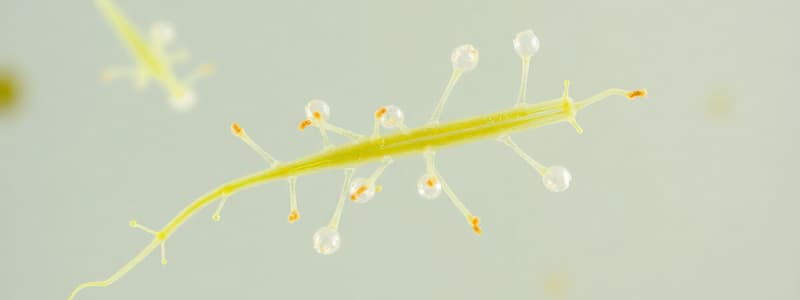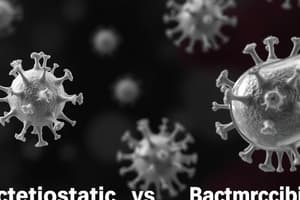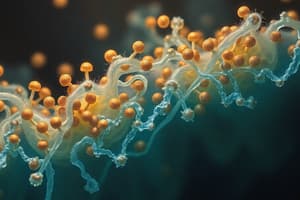Podcast
Questions and Answers
Which of the following accurately describes the role of beneficial microbes in human health?
Which of the following accurately describes the role of beneficial microbes in human health?
- They are responsible for the digestion of all types of food.
- They solely cause diseases by weakening the immune system.
- They are primarily used in industrial applications for food production.
- They aid in digestion, vitamin synthesis, and immune system development. (correct)
What defines the process of sterilization in microbial control?
What defines the process of sterilization in microbial control?
- The reduction of microbial count to safe levels for public health.
- The selective removal of harmful microorganisms.
- The destruction of pathogenic microbes while leaving beneficial ones.
- The complete removal of all microorganisms from a surface or environment. (correct)
What is the primary purpose of culturing microorganisms in a laboratory?
What is the primary purpose of culturing microorganisms in a laboratory?
- To kill pathogens using antimicrobial agents.
- To monitor public health impacts of infectious agents.
- To observe the natural behavior of microbes in the wild.
- To study and manipulate them in a controlled environment. (correct)
How do emerging and re-emerging microbes impact public health?
How do emerging and re-emerging microbes impact public health?
Which technique is vital for identifying and characterizing microbes?
Which technique is vital for identifying and characterizing microbes?
What distinguishes archaea from bacteria in terms of environmental adaptation?
What distinguishes archaea from bacteria in terms of environmental adaptation?
Which of the following statements about viruses is accurate?
Which of the following statements about viruses is accurate?
Which type of symbiotic relationship is exemplified when one organism benefits while the other is harmed?
Which type of symbiotic relationship is exemplified when one organism benefits while the other is harmed?
Which statement correctly describes the structure of eukaryotic cells?
Which statement correctly describes the structure of eukaryotic cells?
What role do microorganisms play in the nitrogen cycle?
What role do microorganisms play in the nitrogen cycle?
Which factor is NOT typically influential on microbial growth?
Which factor is NOT typically influential on microbial growth?
How are microorganisms primarily classified in microbiology?
How are microorganisms primarily classified in microbiology?
What is the primary function of microbial decomposition in ecosystems?
What is the primary function of microbial decomposition in ecosystems?
Flashcards
Microbiology
Microbiology
The study of microorganisms, organisms too small to see with the naked eye.
Prokaryotic Cell
Prokaryotic Cell
A simple cell without a nucleus or membrane-bound organelles. Bacteria and Archaea are examples.
Eukaryotic Cell
Eukaryotic Cell
A complex cell with a nucleus and membrane-bound organelles like fungi, protozoa, and algae.
Microbial Growth Factors
Microbial Growth Factors
Signup and view all the flashcards
Microbial Symbiosis
Microbial Symbiosis
Signup and view all the flashcards
Microbial Competition
Microbial Competition
Signup and view all the flashcards
Microbial Roles in Ecosystems
Microbial Roles in Ecosystems
Signup and view all the flashcards
Microbial Classification
Microbial Classification
Signup and view all the flashcards
Beneficial microbes
Beneficial microbes
Signup and view all the flashcards
Pathogenic microbes
Pathogenic microbes
Signup and view all the flashcards
Microbial control
Microbial control
Signup and view all the flashcards
Sterilization
Sterilization
Signup and view all the flashcards
Microscopy
Microscopy
Signup and view all the flashcards
Study Notes
Introduction to Microbiology
- Microbiology is the study of microorganisms, which are organisms that are too small to be seen with the naked eye.
- These include bacteria, archaea, fungi, protozoa, algae, and viruses.
- Microorganisms play vital roles in various ecosystems and human health.
Microbial Structure and Function
- Bacteria: Prokaryotic cells lacking a nucleus and membrane-bound organelles. Characterized by diverse shapes (cocci, bacilli, spirilla).
- Archaea: Prokaryotic cells, often found in extreme environments. Share some characteristics with bacteria but also possess unique genetic and metabolic properties.
- Eukaryotes: Include fungi (yeasts and molds), protozoa, and algae. These organisms have a nucleus and membrane-bound organelles.
- Viruses: Non-cellular entities composed of genetic material (DNA or RNA) enclosed in a protein coat. They require a host cell to reproduce.
Microbial Growth and Metabolism
- Microbial growth is influenced by factors like temperature, pH, oxygen availability, and nutrient availability.
- Different microorganisms have specific growth requirements, making some suitable for extreme conditions (e.g., thermophiles in hot springs).
- Metabolic processes like respiration and fermentation convert nutrients into energy. Different pathways produce different end products.
Microbial Interactions
- Symbiosis: A close relationship between two different organisms, including mutualism (both benefit), commensalism (one benefits, other is unaffected), and parasitism (one benefits, other is harmed).
- Competition: Microorganisms compete for resources like nutrients and space.
- Predation: Some microorganisms prey on others.
Microbial Diversity and Classification
- Microorganisms display remarkably diverse metabolic capabilities and adaptations.
- Classification schemes categorize microbes based on shared characteristics, including morphology, physiology, and genetics.
- Molecular techniques (like DNA sequencing) are increasingly used for accurate classification and identification.
Microbial Roles in Ecosystems
- Microorganisms are essential for nutrient cycling in ecosystems.
- They decompose organic matter, releasing essential nutrients back into the environment.
- They play key roles in biogeochemical cycles like nitrogen fixation and carbon cycling.
Microbial Roles in Human Health
- Beneficial microbes: Many microbes are essential for human health, aiding digestion, vitamin synthesis, and immune system development.
- Pathogenic microbes: Some microorganisms can cause disease (infections). Understanding their mechanisms is crucial for developing effective treatments.
- Emerging and Re-emerging Microbes: New or reappearing pathogens pose challenges in public health, requiring constant surveillance and research into prevention and treatment strategies.
Microbial Control and Applications
- Sterilization: The complete removal of all microorganisms.
- Disinfection: The reduction in the number of pathogenic microorganisms.
- Antimicrobial agents: Chemicals used to kill or inhibit microbial growth.
- Biotechnology: Microorganisms are used in numerous industrial applications (e.g., food production, pharmaceuticals, bioremediation).
Microscopy and Microbial Techniques
- Microscopy: Essential for observing the morphology and structure of microbes. Techniques like light microscopy, electron microscopy provide different levels of detail.
- Culturing: Microbial growth in controlled laboratory environments is used to study and manipulate them.
- Molecular techniques: PCR, DNA sequencing, immunological tests are vital for identifying and characterizing microbes.
Public Health Impact
- Surveillance systems to monitor emerging infectious agents are critical
- Investigating and tracking outbreaks, understanding transmission methods are vital
- Public health interventions and disease prevention strategies rely heavily on microbiological research
Studying That Suits You
Use AI to generate personalized quizzes and flashcards to suit your learning preferences.




